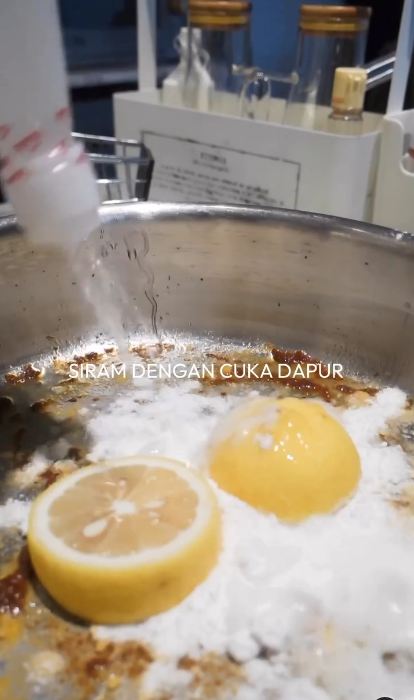foto: Instagram/@rumah.kamali
Brilio.net - A number of cooking activities have the potential to make kitchen furniture dirty. A frying pan is one of the pieces of furniture that is often relied on for cooking various kinds of menus and is prone to getting dirty. Not without reason, frying pans can be used to fry or stir-fry food ingredients.
Well, various cooking processes that involve oil often make the pan slippery and sticky. In some cases, stuck food residue can even produce crusty stains. In fact, this mixture of cooking scale and oil can make the pan more difficult to clean.
The problem of dirty pans due to scale and oil is often experienced by many people, including the mothers of Instagram users @rumah.kamali. Through one of the uploaded videos, he admitted that his stainless steel frying pan had become crusty and full of oil stains because it was used for cooking.
"Indonesians definitely like oily food. You know that, right? If you finish cooking oily food, the pot is still sticky when you wash it. Even though it's really easy to make it scratch, you know," said Instagram @rumah.kamali.
To remove scale and oil stains on a frying pan, usually a number of people will rub it with a wire wool. Even though it can remove the crust, this process has the potential to scratch and damage the pan. In addition, wire wool cannot immediately remove sticky oil stains on the pan. Then, what should I do?
How to clean scale and oil in a frying pan.

photo: Instagram/@rumah.kamali
Instead, Instagram user @rumah.kamali uses other ingredients, namely baking soda, vinegar and lemon slices to clean the scale and oil in the pan. So, to use it, you just need to sprinkle baking soda directly into the pan. Then add the lemon slices and pour in the vinegar until the entire bottom of the pan is completely submerged.

photo: Instagram/@rumah.kamali
Next, cook all these ingredients on the stove for 3-5 minutes over low heat. While it is heating, scrape off the crust and oil stains using a lemon and a fork. That way, the lemon will help remove scale and oil stains stuck to the pan.

photo: Instagram/@rumah.kamali
If the pan is clean of scale and oil, turn off the stove and throw away the dirty cooking water. After that, rinse the pan under running water while rubbing it with a soft sponge and a little dish soap. That way, the pan will be cleaner and rougher.

photo: Instagram/@rumah.kamali
This post about tricks for eliminating scale and oil in pans has been viewed more than 30 thousand times on Instagram. Who would have thought, many other Instagram users said they were amazed by the clean and shiny results of the frying pan. This was expressed directly through the video's comments column.
"Wow, the tips are really cool, aren't they really effortless to clean?" said Instagram @casathehils.
"Wow, this is a cool solution," said Instagram @rumah.zafaz.
"Wow, I'm becoming a doormat again, aren't I?" explained Instagram @isthysyafiq.
"Well, if it's like this, there's no need to rub it with a wire which can damage the pan," said Instagram @widi.nurrohman.
"Thanks for the tips, don't break the pan," said Instagram @nurrin_nurrinawati.
View this post on Instagram
How to choose quality lemons.
Choosing quality lemons is an important step to get fresh and delicious results in your cooking or drinks. Here are nine ways to choose quality lemons:
1. The weight.
Choose a lemon that feels heavy for its size. Heavy lemons tend to be juicier and fresher.
2. Skin texture.
Choose lemons with smooth, non-wrinkled skin. Hard, shiny skin indicates moisture within.
3. Skin color.
Choose lemons with a bright, even yellow color. Avoid those that are too green or too pale.
4. Size.
Choose a medium or large lemon, as they generally have more juice than small ones.
5. Aroma.
Choose lemons that are fragrant and fresh. A strong aroma indicates good essential oil content.
6. Free of defects.
Avoid lemons that have brown spots or blisters on the skin.
7. Thick flesh.
Choose a lemon that feels firm and has thick flesh. Lemons with thin skin tend to have less juice.
8. Free from mud or dust.
Choose a clean lemon with no signs of mud or dust on the skin.
9. Store reputation.
If possible, buy lemons from a trusted shop or market with a good reputation for selling fresh fruit.
(brl/tin)